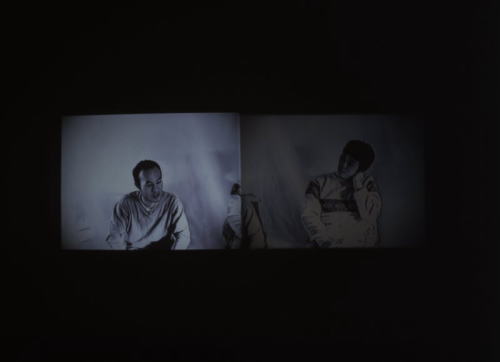|
|
 projects projects |
|
|
|
| Doublogue |
|
| installation with two video projections and two notes.@Sakura City Museum,
Chiba, 1999. |
 |
 |
In the summer of 1997, I happened to be guided to a small, ancient ancestral
shrine at a far-eastern town of the Asian continent. Tsuji Ko, who was with me, and I copied the epitaph that explained the
origin and the history of the shrine. As I was copying the epitaph, I had the idea I would bring this experience
to light one day.Ever since the children I met there asked me, gYou are
a reporter, arenft you?h I began to think that, gI may be a reporter.h What they said might have had an influence on my thoughts and activities.I
wondered what Ko was thinking when he was copying the epitaph.
This experience and the notebooks we wrote at the time are included in
this work. Tsuji Ko is an artist and a friend since college. I have not created a work with him since the summer of 1997. He recently told me that he was going to retrace the roads, from old Manchuria
to Japan, which his mother had walked a half a century ago. Was he serious?
October 1999, TOMITA Toshiaki
In DOUBLOGUE, Tomita wanted to report how the history came his way in a small village
in south China by being a greporterh, the role and identity which was given
to him by local children. He took the word greporterh deeper and questioned
what he was doing, and Tomita played this role in his own unique way. He
decided to report not only gthe historyh but also the reporterfs mind.
Employing methodologies of a documentary, he tries not only to transmit
the information itself but to include his own voice in a bigger soundscape
filled with various voices related to the matter, so that the viewers/audience
should not take his voice as an authority but can realize that they are
free to ask how they might experience it.
In DOUBLOGUE, two synchronized videos are projected side by side, creating a vertical
seam where they meet. The projectfs "narrative" revolves around
an interview between Tomita and his artist friend Ko Tsuji.
Tomita invited Tsuji to this interview/counter interview session,
which took them 4 hours (later edited into 2 hours), based on their common and
unusual experience in a small coastal village in Fujian Province, China, where
they had a 2 month residency in the summer of 1997. One day they two had a walk
in the old village and happened to be guided to a small old mausoleum by local
villagers who later told them how the mausoleum was destroyed and fired by
Japanese marines on a day during the China/Japan war. When Tomita and Tsuji were
led to face the epitaph of the mausoleum, they spontaneously took their own
notes, not a photograph, to copy the text on the epitaph, and that made a huge
difference of their own inner experience and the outer situation. It was a
positive action spontaneously born from inside which even initiated the
situation which lead to a natural and mutual reconciliation between the two
Japanese visitors and the local villagers. For both of them it was a reliable
action because of its accuracy so one of their questions in the interview was
why it can happen to them, what sort of condition lead them to it.
As the
interview unfolds, their conversation touches on history, memories, hidden
meanings and power of tools, family backgrounds, intersubjectivity, temporality,
epistemology and desire. The relationships that emerge between the images on
either side of the central vertical seam and the echo between the two sound
sources serve as a structural score for ideas addressed in the interview, such
that the gaps and overlaps result from their desire to speak a coherent
articulation of time, space, image and identity.
exhibition view
view Ko's note and Toshi's note
"Aren't you a reporter?"
exhibiton view at TUAD
 |
